This review page is supported in part by the sponsors whose ad banners are displayed below |
 |
With orthodox surround recordings emulating a live concert stage in the front and hall ambience in the rear, the DV-6V with Klipsch F2/F1 combo was quite perfect however. Projecting a wide and deep soundstage was effortless, musical involvement second nature. Compared to my mix 'n' match Elekit/Antique Sound Lab combo, the Dared DV-6C had the upper hand in control to attain coherent sonic characteristics and sound-level equilibrium. (While the F1 in the rear channels was 2.5dB less sensitive than the F2, its frequency response is virtually identical). At first resolution seemed somewhat enhanced and the entire bandwidth more informative. But I soon realized that a better way to express the change was more propulsive gusto which rendered the presentation more spirited. Transients were faster, bass was cleaner in 5.0 or 5.1 mode (bass was deeper with the latter of course).
|
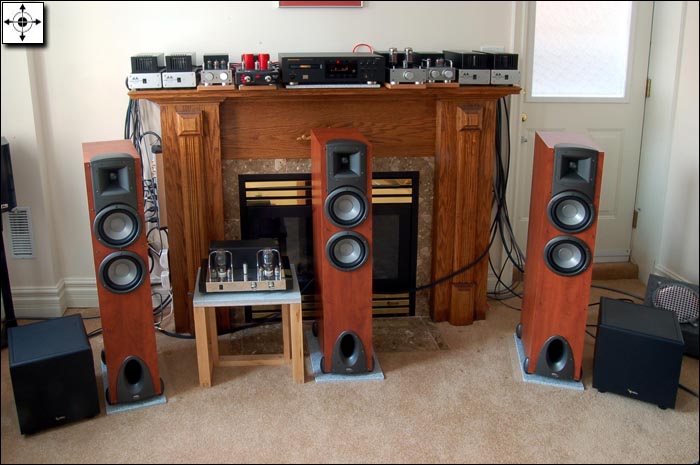 |
The three 12AX7 drivers here are the keys to fine-tune the sound. When I replaced the stock Shuguang with Mullard tubes, the presentation became so rich and warm that blindfolded I’d have identified this as a pure tube amp. With Telefunkens, it remained tube but was more rationally neutral and meticulously articulated. At that point I had to admit to one quibble. The ‘tube cap’ securing device makes tube rolling tedious. Although a single screw tightens the tube cap retainer over the three glass cylinders, one must first remove the bottom panel and 10 screws before one may access the single screw in question through the PCB. Once I had the cap and glass cylinders removed, I didn’t bother putting them back on. The amp looked cool that way and I could roll tubes without turning it upside down again.
|
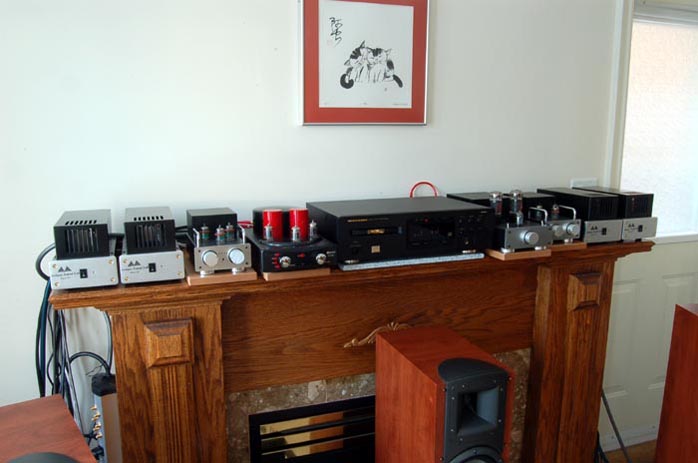 |
|
|
|
SurROUND 2: My second multi-channel system is built around three pairs of bi-amped stacked Loth-X BS-1 in the front and a pair of single-amped Loth-X BS-1 in the back. A Marantz SA8260 is source again and I have three sets of amps to suit my irrational mood swings: four stereo Trends TA-10; four Kingrex T-20/T20U amps with PSU; two Dared VP-20 and one VP-16 bi-amping the fronts; plus my recently acquired JohnBlue TL66 monoblocks for the rears. (I used to have a Dared MP-2A3C in that role but the TL-66 offered a better tube match.)
|
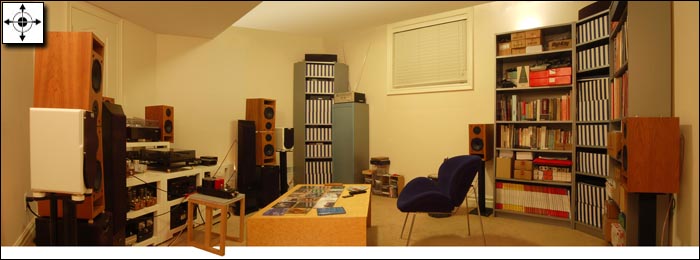 |
For this comparative review, my prevailing mood told me to use tube amps for the reference. Although the VP-20 and TL66 were fitted with Russian OTK 6L6, I was still getting a mix of 6L6 push-pull, 6V6 push-pull and 6L6 single-ended amps delivering output power of 18/12/6wpc respectively (actually 36/24/6wpc considering I bi-amp the fronts). I had to carefully adjust and balance the sound levels between these. Familiar with their behavior, that wasn’t too difficult since I knew how to set their knobs in the ballpark. A diagonal setup proved to work particularly well in this context given that the front speakers are 9 feet apart, the rears 6 feet and my off-center listening position 7 feet from the fronts and 3 feet from the rears. This seating not only fits my front-heavy configuration, the speaker placement achieves more evenly distributed angles of incidence to favor music playback.
|
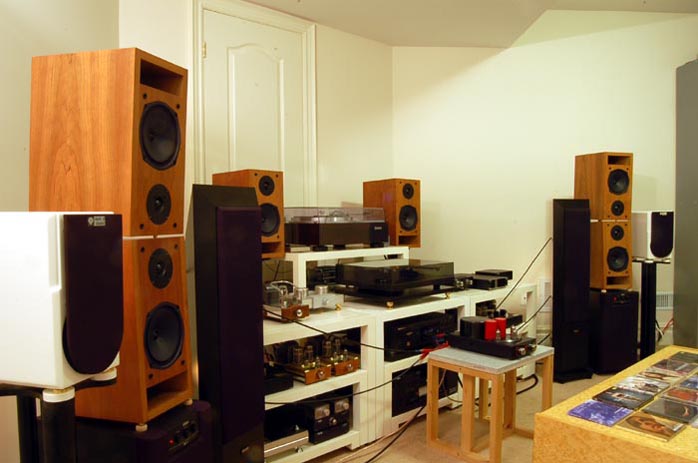 |
The Loth-X BS-1 features a 6” paper cone custom driver with the unadulterated purity of a widebander. To avoid pushing their single driver into a bad castrato that shouts at high pitch, Loth-X cleverly augments it with a crossover-less tweeter. Being a perfect partner for tube, Tripath and chip amps alike, the BS-1 has one advantage over the Klipsch F1 - better-defined imaging. The simple cabinet design helps deliver clean efficient bass. Although on paper LF extension only hits 55Hz, the BS-1 feels uncompressed in the bass and is one of the deepest and healthiest bookshelf widebanders I know. When doubled up by inverse stacking, this speaker has the grandeur of a floorstander and enough lower octave energy to make subwoofers more often than not superfluous.
It’s my main but not sole reason to slight the subwoofer output of multi-channel SACD. My real skepticism is that there’s no dedicated LF channel microphone during multi-channel recording sessions. Since I always use subwoofers in pairs, I simply feed the front left and right channels (from preamp or source) to a pair of Yamaha YST-SW80 active subs. I can thus reinforce low frequencies even with 3.0 and 5.0 multi-channel SACDs. Since each active subwoofer has a pair of line-level inputs, I use Y-adapters at the SACD player’s sub out to feed two subwoofers. With the DV-6C, I connected to the high-level inputs of the subwoofers to fine-tune output from the comfort of my armchair. If that reads too complicated, I made a diagram to visualize the setup.
|
 |
Bearing in mind the Loth-X’s good-natured 94dB spec, the DV-6C had an easy time driving two of them in parallel with its 35w/8ohm rating. My reference tube amps are one of the quietest of their breed yet the DV-6C was absolutely silent. While my reference setup is warmer and brings out more valve magic, the DV-6C carved out better image definition within a wider deeper soundstage and arguably made the multi-channel experience more fun. When fitted with Mullard 12AX7, it didn’t dilute the warmth and aura of full tube amps and only shaved off a very thin layer of lower midrange density which at times could lead to a misjudgment of its bass reproduction. Let me elaborate on the imaging first.
In the past, I have stressed the unsurpassed realism of 3-channel over 2-channel audio on more than one occasion. And I can’t stop myself now. The ultimate showdown between Mercury Living Presence or RCA Living Stereo 3-channel SACD versus their 2-channel versions would easily prove a landslide victory for the former and have me question the whole point of SACD players with only 2-channel playback capability. Pick any title from the Mercury or RCA catalog. If five channels are out of the question, at least consider three. If setting up too many amps was the physical or financial deterrent, the DV-6C clears the path to the ultimate three-dimensional soundstage. Most people might demur that tweaking two speakers for optimal staging is hard enough to not bother with a third. In truth, speaker placement for three channels is a no-brainer and a palpable deep wide soundstage with perfectly localized performers the sure outcome. Finding that extra spot for the third speaker is not as difficult as you might imagine - though finding a seller willing to part with a single speaker might be. You do not want a center channel ‘dialogue’ speaker that can’t sing. It’s partly why I ended up with paired Loth-X for all three front channels.
|
 |
Speaking of strong cases for multi-channel music, the most unfailing of them all has got to be the 2-piano version of Prokofiev’s Cinderella Suite performed by Martha Argerich and Mikhail Pletnev [DGG 474 868-2]. I tried that on all my audio systems and 2-channel mode was flat by comparison each time. History repeated itself with the Dared. In 2-channel mode, the sound images of the two pianos overlapped at certain mid frequencies into one four-handed piano to diffuse the excitement of the interactions between two pianos. Multi-channel presented the two pianists and their discrete instruments on a wide concert stage over the entire frequency spectrum and the entire repertoire of the album. The witty rapid dialogues in “Quarrel” for instance exchanged feverishly with all their intricacy. Here the DV-6C surpassed my reference system in clarity and dimensionality. The soundstage was even deeper and wider, set back the pianos by another 2 or 3 feet and much further apart. The higher octaves were more crystalline, the lower ranges tighter and crisper yet the ambience was airier and had slightly longer decays. Immediate A/B comparison led me to think that the all-tube system had deeper bass and richer midrange which prompted me to switch in the subwoofers on the Dared and raise the crossover point. I seldom resist the temptation of subwoofers for piano playback.
|
|
|
Similarly with Shostakovich’s Piano Trios played by Kempf Trio [BIS-SACD-1482]. The DV-6C projected an emotionally close-knit musical triangle into a believable sonic perspective with three-dimensional embodiment. While my reference tube system dwells on the emotions to have nothing to apologize, the DV-6C meticulously rebalanced the scale to greater neutrality. This benefited complex symphonic works with spontaneous clarity and natural airiness. The Dared DV-6C didn’t aimlessly shoot for higher resolution but maintained an elegant polish. Otherwise vocal recordings could have ended up with excessive sibilance on the Loth-X. Frommermann’s Music of the Comedian Harmonists [Channel Classics CCS SA 26807] put this to the test.
|
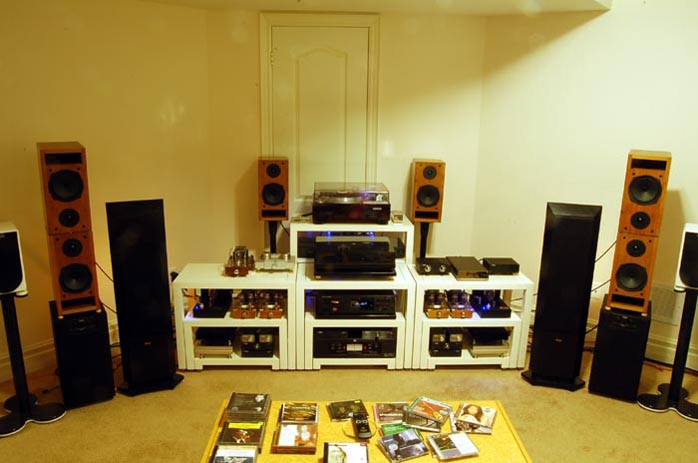 |
I deliberately turned the subwoofers off and was surprised to find the high registers so gentlemanly suave. I could have used some subwoofer reinforcement I first thought. But when it came to “In einem kühlen Grunde” and “Lebe wohl, gute Reise”, the tonal spectrum was so finely balanced that I preferred leaving good enough alone. I finally played the Rodrigo Concierto Andaluz for Four Guitars [Mercury 475 6784 2] and was convinced that in this setup even without subwoofers, the DV-6C was not bass shy in the least. |
  |
 |
|